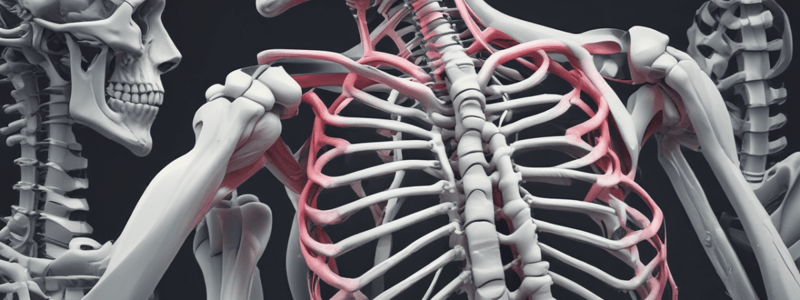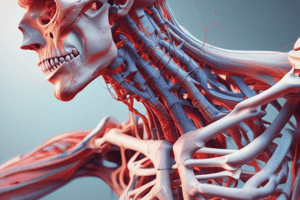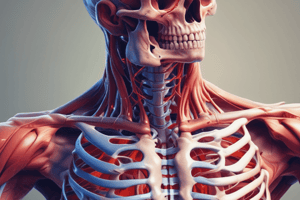Podcast
Questions and Answers
Match the following components of the locomotory system with their descriptions:
Match the following components of the locomotory system with their descriptions:
Bones = Composed of ground substance, mineral salts, and cells like osteocytes Muscles = Responsible for all body movement due to their ability to contract Joints = Provide the body with a supportive framework allowing flexibility of movement Periosteum = A fibrous membrane surrounding the bone made up of connective tissue, vessels, and nerve fibers
Match the following bone components with their functions:
Match the following bone components with their functions:
Matrix = Gives bone its characteristic properties by providing resilience Mineral salts = Provide hardness to the bone when deposited among protein fibres Compact bone = Hard, dense shell with fine channels for blood vessels to enter Spongy bone = Located inside the compact bone and contains bone marrow for cell formation
Match the following bone properties with their outcomes:
Match the following bone properties with their outcomes:
Destroyed fibres = Results in brittle bones Dissolved salts with acid = Causes bones to become rubbery Presence of protein fibres = Confer resilience to the bone Insoluble mineral salts = Provide hardness to the bone structure
Match the following bone marrow cells with their products:
Match the following bone marrow cells with their products:
Match the following bone components with their composition:
Match the following bone components with their composition:
Match the following bone properties with their effects:
Match the following bone properties with their effects:
Match the following bone marrow components with their products:
Match the following bone marrow components with their products:
Match the following locomotory system components with their functions:
Match the following locomotory system components with their functions:
Match the following bone structure parts with their descriptions:
Match the following bone structure parts with their descriptions:
Match the following locomotory system components with their characteristics:
Match the following locomotory system components with their characteristics:
Match the following bone components with their composition:
Match the following bone components with their composition:
Match the following bone properties with their outcomes:
Match the following bone properties with their outcomes:
Match the following bone marrow components with their products:
Match the following bone marrow components with their products:
Match the following locomotory system components with their characteristics:
Match the following locomotory system components with their characteristics:
Match the following components of the locomotory system with their functions:
Match the following components of the locomotory system with their functions:
Match the following components of bone structure with their descriptions:
Match the following components of bone structure with their descriptions:




